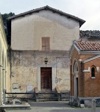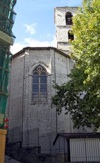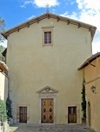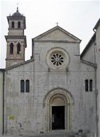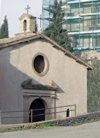Public Palaces
Palazzo Comunale (on the left in this photograph), which was first documented in 1273, was rebuilt in 1522-6 and re-modelled after the earthquake of 1703. The Torre del Comune (13th century), to the right of it, owes its present appearance to the restoration of 1691. The buildings to the right of the Torre del Comune stand on the site of the medieval Palazzo del Capitano del Popolo.
Patrician Palaces
The patrician palaces of Trevi have two pages in this website:
-
✴One describes those belonging to the Valenti family:
-
•Palazzo Valenti, il Collegetto (1534);
-
•Palazzo dei Valenti di Riosecco (1545-56);
-
•Palazzo Valenti (1575), illustrated here; and
-
•Palazzo Valenti della Prepositura (ca. 1650).
-
✴The second page describes:
-
•Palazzo Approvati (1497);
-
•Palazzo Lucarini (15th century);
-
•Palazzo Natalucci (date ?), illustrated here;
-
•Palazzo Petrelli (16th century);
-
•Palazzo Petroni (ca. 1600); and
-
•Villa Fabri (1603).
Rocca di Trevi (1421)
Piazza della Rocca must have been the site of the Rocca di Trevi, which Corrado Trinci built in 1421 and Francesco Sforza destroyed in 1424. It is odd that a structure that lasted only three years is still remembered in the name of the piazza: it is possible that an earlier fortress had existed on the site.
Sant’ Antonio Abate (1616)
This complex belonged to the Capuchins, who were established at Trevi in 1559 in a hermitage near this site. The community was suppressed in ca. 1860 and the church subsequently served the civic cemetery.
San Bartolomeo (14th century)
This complex, which was documented as a nunnery in 1385, was in private hands in 1495, when a small community of women managed to acquire it and reinstate it as a nunnery. They established an orphanage here in 1796. The complex was subsequently adapted to form apartments.
Santa Chiara (1666)
According to some authorities, a nunnery here belonged to a community of Poor Clares from at least the late 13th century. However, it is documented only from the 16th century. Bishop Cardinal Cesare Facchinetti of Spoleto commissioned the present church.
Santa Croce (ca. 1685)
A Benedictine nunnery here absorbed another nunnery, Santa Maria Maddalena in ca. 1368, when this second nunnery was demolished. Its church was destroyed by fire in 1394. [Subsequent history?]
San Domenico (demolished)
Virgilio Lucarini gave a site in Piazza Garibaldi to the Dominicans in the 17th century. His nephew, Reginaldo, who belonged to the Dominican Order, gave part of his considerable inheritance to the complex. The community was suppressed in the Napoleonic period and the hospital from San Giovanni Decollato was moved to the site. This photograph shows the Dominican complex after its adaptation to house the hospital and before its subsequent demolition.
Sant' Emiliano (1856-93)
This was probably the site of the burial of St Emilianus in the 4th century. The church on the site was probably destroyed and the relics taken to Spoleto after the Spoletans destroyed Trevi in 1214. Its successor was documented in 1226: three small apses and part of its right wall survive. It was rebuilt on a larger scale in 1465-85, and Pope Paul II raised it to the status of a canonical college. It was consecrated in 1522 and largely rebuilt in the 19th century.
San Francesco (1354)
The original church on this site was destroyed (like the rest of Trevi) in 1214. The Franciscans built a new church on the site in ca. 1268 below the level of the present structure, which was begun in 1354. This church, which was originally dedicated to the Blessed Ventura, was re-dedicated as San Francesco in 1477. The Franciscan community was suppressed in 1810. The church was restored in 1910 and re-opened briefly. It is now de-consecrated and forms part of the museum complex of Trevi.
San Giovanni Decollato (re-modelled in ca. 1832)
This original church here, which belonged to the Commune, was probably built soon after the sack of Trevi in 1214. An adjacent hospice was documented in 1291. In 1501, the Commune united it with its other church, the Madonna delle Lacrime, which was administered by a community of Lateran Canons. In 1570, the Commune ceded it to the Compagnia della Misericordia. The hospital remained in use until the Napoleonic period, when it was transferred to the suppressed convent of San Domenico (since demolished). The church were re-modelled in ca. 1832.
Santa Lucia (1344)
There has been a Benedictine nunnery here since 1344. The piazza in front of the the church was laid out in its current form in 1586 and the church itself was rebuilt in 1635. The nunnery of Sant' Alò, Spoleto was merged with this community in 1965 and the nuns from Spoleto finally moved here in 1974.
Madonna delle Lacrime (1487-1514)
This church was built to house a miraculous fresco (1483) known as the Madonna delle Lacrime. It was still in construction in 1500, when it was taken over by Lateran Canons.
Santa Maria di Pietrarossa (13th century)
The church is named for a tablet of red marble that is now on the second pillar on the right. It stands beside the line of the Roman Via Flaminia, and was probably at the heart of the colony of Trebae. The church contains some important frescoes but they are in a poor state of repair. [
The church is now, unfortunately, closed.]
San Martino (15th century)
This was the site of the ancient San Martino della Pieve, the original parish church of Trevi, which was first documented in 1235. Its goods passed to Sant’ Emiliano in 1430, and the church itself passed to the Valenti family. They ceded the complex to the Observant Franciscans in 1479. [Later history ?]
San Pietro in Bovara (12th century)
This Benedictine abbey was first documented in 1177. An inscription records the church as the work of Atto. St Francis stayed here after the destruction of Trevi in 1214, when the abbey was effectively abandoned. The monks subsequently returned, and the abbey was controversially united with Santa Croce di Sassovivo (outside Foligno) in 1334. Pope Eugenius IV re-established the abbey's independence in 1442, and it passed to the Olivetans in 1484. It was suppressed in the Napoleonic period. The Curia subsequently recovered it but transferred it to the Martinez family in payment of a debt. The church now serves the local parish.
San Tommaso (12th century)
Part of the original church of San Tommaso survive, along with part of an adjacent and slightly older building that probably housed the hospice for lepers that is documented from the early 13th century. The complex subsequently passed to the Valenti family, and they restored the church in 1609. Ownership passed to the Congregazione di Carità in ca. 1860 and the complex was largely rebuilt as a farmhouse.
Small Churches
The following churches are described in this page:
-
✴Sant' Antonio da Padova (13th century), illustrated here;
-
✴Chiesa del Crocifisso (1562);
-
✴Chiesa dell' Ospizio (1517);
-
✴San Fabiano (12th century);
-
✴San Filippo Neri (1643);
-
✴Santa Maria in Sion (17th century);
-
✴San Pio V (1600);
-
✴Santa Reparata (1578); and
-
✴Santo Stefano (12th century).
Return to the home page on Trevi.





